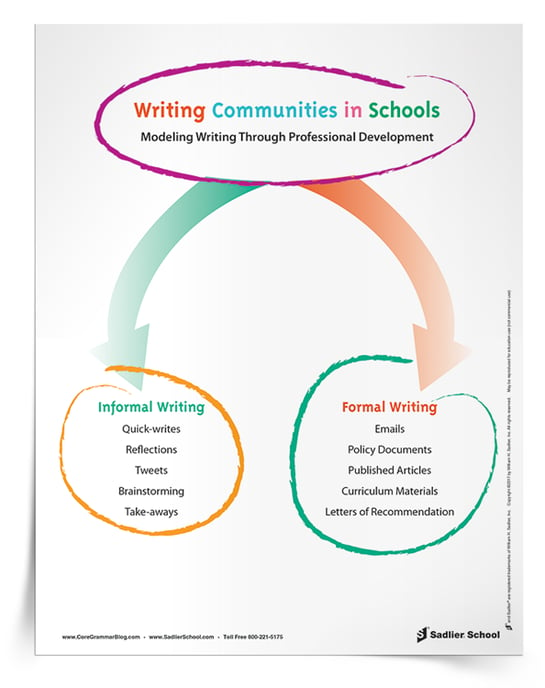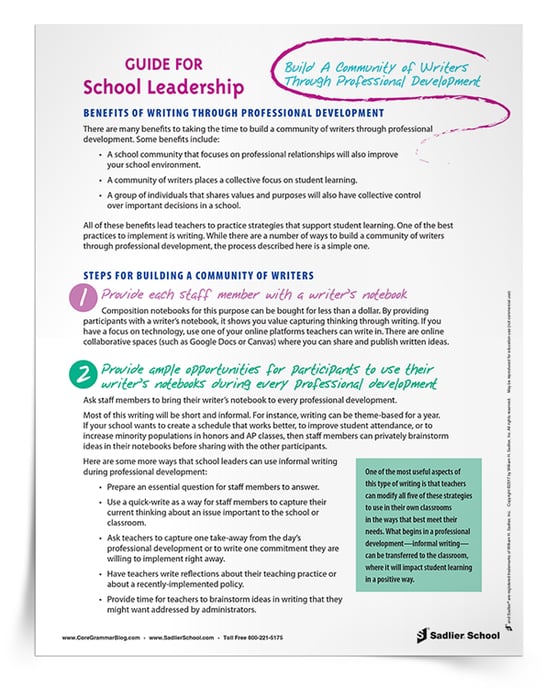May 4, 2017 ELA K-5, ELA 6-8, ELA Resources - Tip Sheets, ELA Focus - Writing, ELA 9-12, ELA PD - Leadership, ELA PD - Grammar Writing, Core Grammar
How Professional Development Can Support Writing Communities in Schools
By: Tiffany Rehbein
Professional development days are my favorite! How often do school leaders hear teachers in their schools say this? In this blog post, you will learn about the benefits, processes, and ways to introduce writing into professional development in order to build a community of writers at your school.

Building a community of writers in a school might be one of the most powerful steps school leadership can take.
In a prior blog post, Community of Writers, I discussed ways in which a school community can build a community of writers. This is not an easy task nor is it a task that can be accomplished after just one faculty meeting or required staff development. Rather, a community of writers takes time to build; the identity of the group will emerge and develop just as individual personalities develop and emerge.
Here are a few items to keep in mind as you build a community of writers:
-
Model respect for writing and writers
-
Discuss writers and writer's lives
-
Use writing consistently
-
Believe writing is for everyone
BENEFITS OF WRITING THROUGH PROFESSIONAL DEVELOPMENT
There are many benefits to taking the time to build a community of writers through professional development. Some beneifts include:
-
A school community that focuses on professional relationships will also improve your school environment.
-
A community of writers places a collective focus on student learning.
-
A group of individuals that shares values and purposes will also have collective control over important decisions in a school.
All of these benefits lead teachers to practice strategies that support student learning. One best practice to implement is writing. While there are a number of ways to build a community of writers through professional development, the process described here is a simple one.
STEPS FOR BUILDING A COMMUNITY OF WRITERS DURING PROFESSIONAL DEVELOPMENT
STEP 1: PROVIDE EACH STAFF MEMBER WITH A WRITER’S NOTEBOOK
Composition notebooks for this purpose can be bought for less than a dollar. By providing participants with a writer’s notebook, it shows you value capturing thinking through writing. If you have a focus on technology, use one of your online platforms teachers can write in. There are online collaborative spaces (such as Google Docs or Canvas) where you can share and publish written ideas.
STEP 2: PROVIDE AMPLE OPPORTUNITIES FOR PARTICIPANTS TO USE THEIR WRITER’S NOTEBOOKS DURING EVERY PROFESSIONAL DEVELOPMENT
Ask staff members to bring their writer’s notebook to every professional development.
Most of this writing will be short and informal. For instance, writing can be theme-based for a year. If your school wants to create a schedule that works better, to improve student attendance, or to increase minority populations in honors and AP classes, then staff members can privately brainstorm ideas in their notebooks before sharing with the other participants.
Here are some more ways that school leaders can use informal writing during professional development:
-
Prepare an essential question for staff members to answer.
-
Use a quick-write as a way for staff members to capture their current thinking about an issue important to the school or classroom.
-
Ask teachers to capture one take-away from the day’s professional development or to write one commitment they are willing to implement right away.
-
Have teachers write reflections about their teaching practice or about a recently-implemented policy.
-
Provide time for teachers to brainstorm ideas in writing that they might want addressed by administrators.
One of the most useful aspects of this type of writing is that teachers can modify all five of these strategies to use in their own classrooms in the ways that best meet their needs. What begins in a professional development—informal writing—can be transferred to the classroom, where it will impact student learning in a positive way.
BRIGHT IDEA: Is there an offsite district-wide training coming up? Ask them to write down three key learnings in their writer’s notebook. Return to those learnings at your next faculty meeting. Encourage teachers to go back to their writing and share in the building.
STEP 3: SCHOOL LEADERSHIP NEEDS TO ENGAGE IN WRITING AND MODEL BEST PRACTICES
Staff members need to see leaders of professional development engaging in writing. They need to hear stories about how writing has helped leaders develop, process, and think through issues that are important to the school and to those who work in the school.
Show staff how to use writing, whether it’s writing with them, sharing snippets of published works, or sharing a Tweet.
Not all of the writing carried out in a professional context should be informal. There are countless opportunities for school employees to write formally.
Email is the most obvious example. Teachers often use email to communicate with counselors, parents, and other teachers. These are formal—possibly legal—documents that represent individuals and the school.
Other types of formal writing include writing for publication, composing policy documents, or publishing curriculum documents.
In addition to sharing your own writing, give teachers an opportunity to reflect through writing, to answer an essential question, or to address an issue or goal for the year.
Download a graphic as a reminder for the types of writing that can be easily implemented in your school culture, as you model writing through professional development. This poster can be hung during staff meetings or be printed and shared with teachers.

BRIGHT IDEA: Writing is no longer confined just to the school. If your teachers use Twitter, show how writing looks, using 140 characters or less. More importantly, keep in mind modeling ways to write, if a school leader uses Twitter, when you promote, invite, and show teachers how an online profile can be used to improve student learning.
STEP 4: DIALOGUE THROUGH PROFESSIONAL DEVELOPMENT WRITING
The overall goal of creating a community of writers through professional development is to promote sharing!
Don’t make sharing mandatory. Because not everyone identifies as a writer or believes his writing is worth sharing, the best approaches are to model and to build trust while everyone writes and shares, whether the writing is formal or informal.
Let staff members share what and when they are comfortable. If you want to hear everyone’s voice, provide an exit slip, either on paper or electronically, for teachers to write on.
Download and share a Guide for School Leadership: Build A Community of Writers Through Professional Development.
IN SUMMARY
School leaders can use professional development to build a community of writers school-wide.
School leaders don't need to focus on making professional development days the best days of the year. They can, however, model best practices and give teachers tools they can take back to the classroom.




